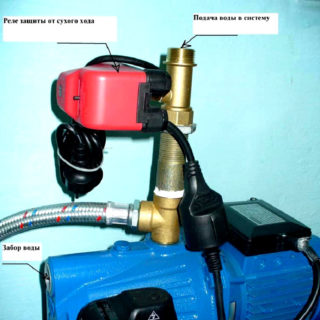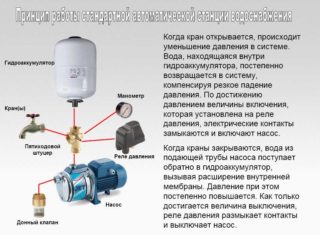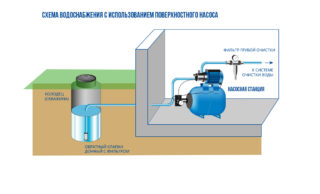The pumping station has a number of advantages over simple pumps: the presence of a storage tank, additional protective functions, several operating options - automatic or semi-automatic. In order to extend the service life, the unit must be correctly selected and installed. The choice depends on several criteria - the number of people in the house, the type of reservoir, the possibility of installation in a technical room.
Types and principle of operation of pumping stations for summer cottages
The advantage of a water supply pumping station for a summer residence is that all components are included in the kit. You can assemble a system from individual components with your own hands, but it will take longer, in addition, self-made units are more likely to fail. Factory equipment works up to 15 years without the need for repairs, if all operating rules are followed.
Installations are distinguished according to the following characteristics:
- Suction type. There are models with an internal and external ejector. Units with a built-in device are not afraid of the presence of air or gases in the pumped medium (after all, not all owners buy pumps for pumping water), and also do not break due to dirt entering the mechanism. The disadvantage of the built-in ejector is in a rather noisy operation, as well as a low power, capable of lifting water from a depth of only 9 meters. Models with a remote device are much more sensitive to dirt and air bubbles, but less noisy, therefore they are more often installed indoors. The power of such models is higher - they lift liquid from 45 meters.
- Type of fluid supply: models with a hydraulic accumulator and a storage tank. The storage tank has a volume of up to 300 liters, which can provide a family of three with water for a day. The accumulator is a membrane tank with a volume of 8–20 liters. With an increased flow rate in the morning and in the evening, the pumping station turns on more often.
- Type of source for water intake: surface and submersible. In surface models, the equipment is above the ground and the pipe is lowered into the well. The second type involves the complete immersion of equipment in a well or borehole.
In terms of capacity, mini units stand out among the range. The principle of operation of such a pumping station for a summer residence is different in that it is used with an irregular need for water.
Criterias of choice

In order for the device to work for a long time and without interruptions, it is not recommended to save money on the purchase of a pumping station. It is important to strike a balance between the needs of the family and quality materials.
The size of the storage tank is important if all the liquid is consumed per day.In this case, energy is saved, since the unit is turned on 1-2 times a day, and there is always water in the system. If the liquid stagnates, it acquires a specific smell and taste, as it is in a rubber bag.
Depending on the height to which it is necessary to raise the water, the equipment is selected according to the magnitude of the pressure. You can choose a device with a large supply of liquid, but then the pressure in the tap will be less, or vice versa: there is less water supply, but the pressure is stronger. For a small house or summer cottage, 1-2 bar is enough, for a large two-storey house, an indicator of 4-6 bar is required.
The materials used in the manufacture of pumping stations must be separately indicated in the instructions for the product:
- The body can be made of plastic, cast iron, stainless steel or black steel. It is not advisable to buy plastic if long-term regular use is planned - these are budget models for summer cottages or for a house in which one person lives. Cast iron is the most durable material, but it is expensive. The best option is steel cases. To protect them from corrosion, a layer of special paint is applied.
- The motor shaft must be made of heat treated stainless steel. This is the most vulnerable point of the pump, because it is most exposed to water.
- The impeller is made of ultra-resistant polymers because it has to withstand the enormous head of fluid. A good option is stainless steel, but over time it still undergoes rust formation, and the unit fails.
- Seals are important parts of the system as they control leaks and pressures. In expensive models, braided asbestos thread seals are used as a sealing material, inside which copper elements are inserted.
An important element of the system is the presence of protection against dry running, in which the automation switches off the equipment. In summer, drought is often observed and the water goes deep, so the best option would be to install a pumping station with this function. Many buyers speak well of the electronic relay with a display that allows you not to think about pressure regulation.
The volume of the storage tank does not correspond to the figures in the instructions: some part of it is always occupied by compressed air, so the maximum amount of water will be less than the specified value.
Installation methods
The best place to install a pumping station is in the basement. So the device will be protected from harmful environmental influences at any time of the year. To eliminate vibrations and reduce the force of a running pump, a rubber mat is placed under it.
The second common method is to equip a special room with a lock on the street. In this case, the station will not be heard. Wall insulation will be required to maintain the temperature.
The third method is installation in the ground. The pit is dug near the well to a depth below the freezing of the soil.
Operating and maintenance conditions
- it is advisable to organize ventilation in the room so that condensation does not collect;
- pipes from the pumping station must be laid so deep that they do not freeze, in addition, use insulation to protect against severe frosts;
- it is necessary to install a voltage stabilizer so as not to damage the engine;
- before the first start-up of the equipment, the hydraulic tank is filled with water.
In order not to clog the inside of the pump with dirt and sand, it is recommended to install a coarse filter at the end of the pipe, which is located in the well, without fail. If you want to receive clean drinking water from the tap, a fine filter is installed at the entrance to the house. It can be removed, cleaned and put back at any time.
If a check valve is not included in the package with the pumping station, you need to buy it separately, otherwise some of the water will flow back into the well, and the frequency of starts will increase.
An important point is the state of plumbing fixtures. With a faulty toilet cistern, when water constantly flows out, the pressure in the system will often drop, and the pump will turn on more times. This leads to rapid wear of the parts.
Advantages and disadvantages of using a pumping station for a summer residence
The pros and cons of pumping stations directly depend on how correctly the calculations were made and the device was installed. If a steel casing is installed in a humid, damp room, no matter how good the pump is, it will quickly deteriorate under the influence of rust.
Pumping stations are definitely more convenient and reliable than cheap devices that must be turned on and off on their own. The only condition is the correct calculation of water consumption and high-quality installation of the product.
Imported units will cost more than domestic pumping stations. However, a variety of models from foreign manufacturers will allow you to choose the most suitable option for your home.










